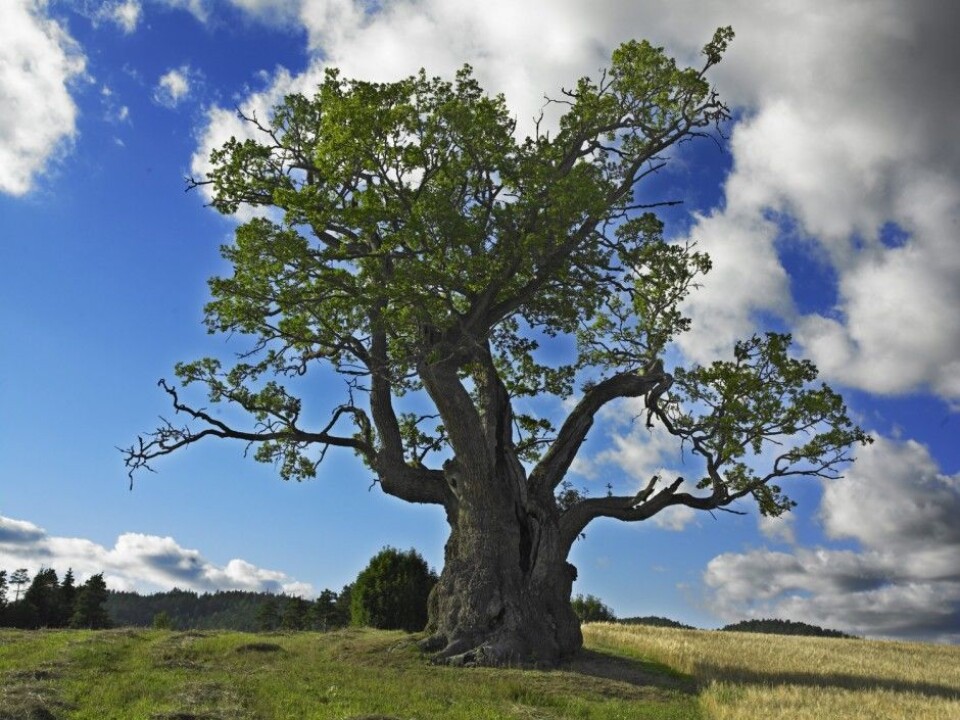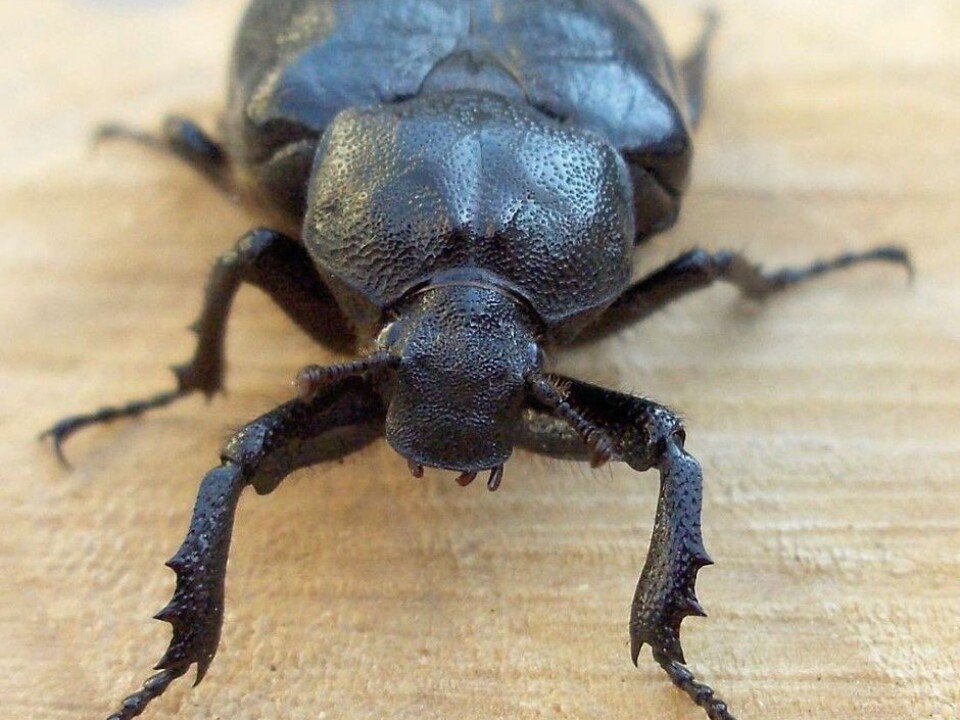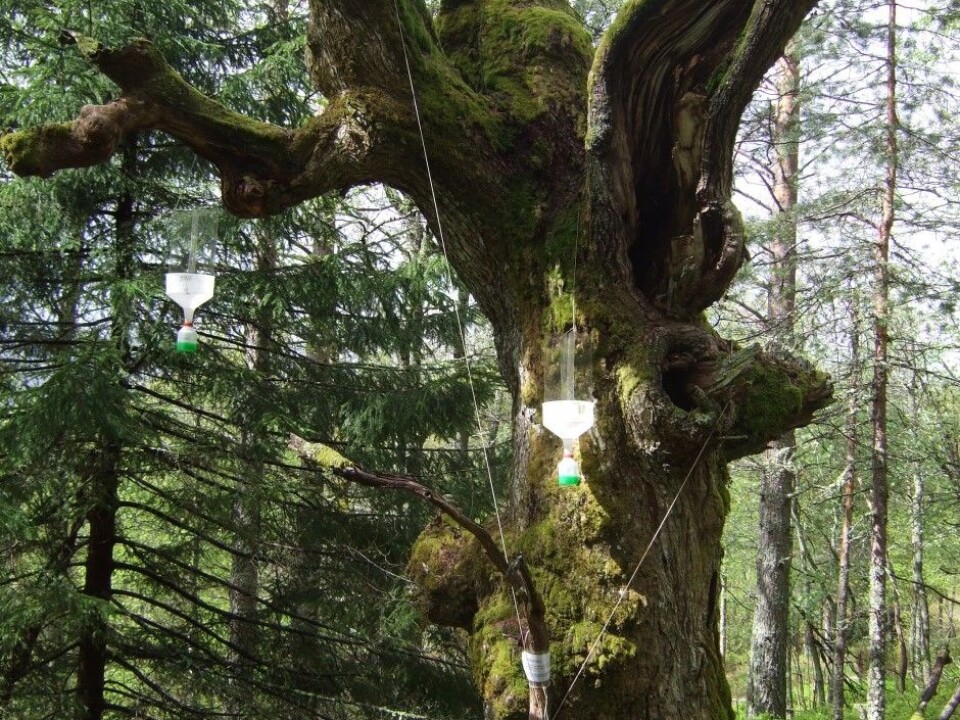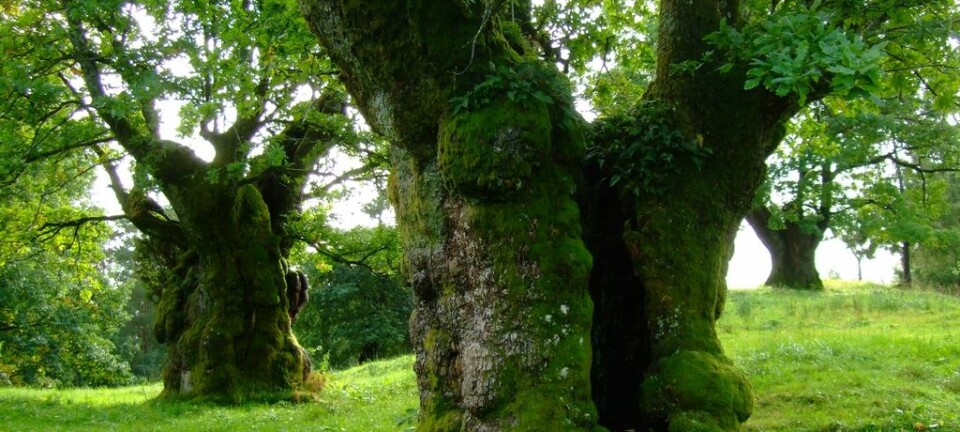
Life extinguishes in lonesome oaks
Hundreds of insects, lichens and fungi live in the hollow spaces of centuries-old Norwegian oaks which are the verge of disappearing.
Denne artikkelen er over ti år gammel og kan inneholde utdatert informasjon.
Life inside old oaks plays out at a snail’s pace. But these tree dwellers now risk paying the ultimate price as a result of the extensive cutting of trees in 16th and 17th centuries.
Hanne Eik Pilskog, a PhD candidate at the Norwegian University of Life Sciences in Ås, has spent two years investigating the hollow cavities of old oak trees in the Agder Counties and around the town of Larvik.
She is concerned about the phenomenon that biologists call the extinction debt – the future extinction of a species due to events in the past.
Extinction debt from the 1500s-1600s
These species face extinction because they have not had time to respond to changes and are not in balance with their surroundings. They may face the complete elimination of places where they live.

For some species the debt can stretch back hundreds of years, instead of resulting from more recent damage to the environment being done by the explosive growth of fossil-fuel-burning bipeds.
The debt can only result in species extinction.
Oak forests once covered large parts of southern Norway. But in the 1500s and 1600s they were cut to build ships in Norway and at shipyards further south in Europe where oaks were a commodity in demand.
Oaks from the southern part of Norway also made it possible to build what was then one of the largest metropolises in the world, Amsterdam, out of marshlands.
Few oaks left

Norway now has anywhere from 5,000 to 80,000 hollow oaks left. The number is uncertain because they are few and far between and no complete tally has been made.
Oaks can survive for centuries and even a thousand years.
The oaks that were not chopped down in 16th to 19th centuries are now often found on small mounds or on southerly slopes in spots where they were hard to be cut.
Others stand large and elegant, in the middle of fields or by old farmhouses.
1,500 species dependent on old oaks

“When an oak gets old it develops a number of microhabitats that are not found in younger trees,” Eik Pilskog explains.
“These microhabitats consist of dead branches, rugged bark, hollow spaces with wood mould and various stages of rot. Nearly a thousand different species of insects can depend on these large old oaks.”
Hollow oaks are also home to several hundred fungi and lichen species.
Many of the 1,500 species of flora and fauna cannot live anywhere else other than in the cavities of these trees.
Testing the hypothesis of extinction debt
“Our hypothesis is that much of the life in the hollow Norwegian oaks has not yet ‘paid’ its extinction debt,” says Eik Pilskog.
The habitat of species that live in trunk hollows has shrunk enormously since the 1600s. But much of the life the old deciduous trees supported has hung on for hundreds of years.
“We fear that these species will die out. They just haven’t had time to do it yet,” Eik Pilskog said.
She has undertaken some labour-intensive research to test her theory.
She has been investigating oak trees along the coast and inland one by one. Trees along the coast were cut first because they were the easiest to transport. Old oaks further from the shore in South Norway were allowed to stand another century or two.
As a point of departure, we can assume that the greatest richness of species will be found in the trunk hollows of the oaks closest to the coast. This is where it is warmest and wettest and the climate is the most hospitable for trees and the insects dwelling in them.
But if Eik Pilskog makes contrary finds, meaning that the most prolific trees are found inland, this could confirm the hypothesis that life in the old oaks is indeed living on borrowed time, and that the species that live there owe an extinction debt. These species are still dying out even if more oaks are not cut in their vicinity.
Little known about life in the oaks
“I’m especially concerned about the beetles that reside in the hollow oaks,” says Eik Pilskog.
One hollow oak species thought to be extinct was the hermit beetle – also know as the Russian leather beetle (Osmoderma eremita). It was believed to be extinct in Northern Europe until a few were discovered in hollow trees in a graveyard in Tønsberg Norway in 2009.
The beetle is red-listed and highly endangered.
The hermit beetle is a good example of insects that the Eik Pileskog would categorize as having an extinction debt. Unless some fortuitous event occurs it will vanish in a few years.
The research fellow says we know little in general about life in old Norwegian oaks.
“Something we do know is that there is much diversity from one tree to another. Some have lots of species, others don’t.”
We can help the oaks
“A problem for life in the surviving old oaks is that there is such a distance between them,” says Eik Pilskog.
“When they are several kilometres apart it is pretty much impossible for a beetle to spread from tree to tree. A large beetle like the hermit rarely travels more than 200 metres in the course of its life.”
The biggest threat to these trees is comprised of the many small changes Norwegians make in their landscape. Or sometimes it’s simply a lack of concern.
When the ancient oaks disappear they are not immediately replaced by other old oaks. These are few and far between.
Those who own these oaks or know people who do should stand up and protect the oaks when new roads and buildings are under construction, or when pipes and cables are lain underground.
The number of trees in Norway is actually growing. There are three times as many new trees in Norway as there in the interwar period. So there are constantly new spruces and other types of vegetation growing up between the old oaks. They shade the old giants and hasten their deaths.
Norwegians can help by clearing vegetation around the trees.
Dead branches and rotten wood are natural features of old oaks and not a sign that they are diseased. Owners can be reminded of this.
Pruning branches on large old oaks is often unnecessary. Professional tree toppers should be summoned if withered branches are in danger of falling on people or the crown needs to be topped to keep a tree from falling.
Old trees in Sweden
Sweden is one of the countries in Europe where quite a few ancient oaks still survive.
This is because the Swedish kings forbid the chopping of valuable trees.
But many were felled when the ban was lifted in the 1800s, partly as acts of protest against the nobility and the Lutheran Church.
This is why many of the survivors in Sweden are found on the former properties of the nobility and church lands.
Researcher Nicklas Jansson at Linköping University has been begun a study to see if he can address the loss of these species. He hung up hollow boxes on old oaks and placed old mouldy wood and other materials inside that simulated trunk hollows.
“This was a success. A total of 70 percent of the original life forms in the trunk hollows made footholds in the boxes. The project has now been running for ten years.”
“It would be fascinating to try the same thing here in Norway,” Eik Pilskog says.
----------
Read the Norwegian version of this article at forskning.no
Translated by: Glenn Ostling































